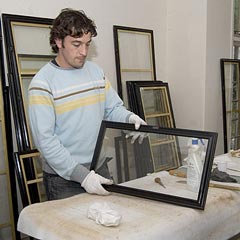Restoring the paintings

Kew's restorer at work
Marianne North painted her illustrations on a paper of medium thickness. Ten years after the opening of the Gallery, the paintings were fixed on to card to prevent them sagging. However, this card was acidic and is now affecting the paintings themselves. Eleanor Hasler, Kew's MNG Conservation Surveyor, talks here about the process.
A detailed survey
At present I am taking each work of art out of its frame to examine the painting and its substrate. This is painstaking work, as the paint is flaking in certain places. I have to keep even the smallest flakes so the painting can be restored.
I am making detailed notes on every painting and adding it to our database of conservation needs. The survey includes the decoration on the door panels and surrounds and a further 16 paintings which were removed from the Gallery in 1953 due to damage of the clerestory area and have not been seen by the public since.
Stepping back in time
Looking at her paintings in detail, it's fascinating to be able to see how Marianne painted. She was apparently intolerant of 'rules' in art and this can be seen in her painting technique. A rough sketch in pen and ink was first made on to the prepared paper and then she would apply the colours, squeezed straight from the tubes.
When I remove paintings from their frames, I'm making other discoveries that I wouldn't have anticipated. For instance, on the reverse of one painting I found detailed notes about the sloth it depicts, including how long Marianne watched it for and what it ate.
Marianne carried out considerable alterations to some of the images to fit her hanging scheme. You can clearly see where she has stuck on additional pieces of paper and simply extended the painting over the new material so that she would fill the space she wanted in the Gallery.
Once the full conservation programme is underway, we will clean, in-paint and reattach the paintings to specialised board. Some paintings may also require re-lining, a time-consuming and intricate process, which requires a great deal of nerve and patience. At present we think the conservation work will take about two years.
I can honestly say that working on the paintings of such a remarkable woman in such detail is a real privilege.

